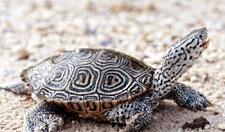Wildlife - Species

Specific Regulations
Diamondback Terrapin
In 2006, Chapter 5 Section 50-5-2300 of South Carolina law was amended to read, "It is unlawful to take or possess diamondbacked terrapin for a commercial purpose. A person may possess no more than two diamondbacked terrapin for a noncommercial purpose. Nothing in this section prohibits the incidental catch of terrapin by persons engaged in a lawful fishery when the terrapin are returned immediately to the water."
The status of the species is listed as unknown in South Carolina (S?) and apparently secure globally (G4).
Diamondback Terrapin (Malaclemys terrapin)
Description
Diamondback terrapins belong to a family containing more genera and species than any other family of living turtles, the Emydidae. The diamondback terrapin is the only species included in the genus Malaclemys, but several subspecies are recognized even though experts have not come to an agreement on the exact number. The terrapins' shell, or carapace, ranges in color from light brown to gray to black with a honey-yellow or greenish underside. The sections of the carapace, called scutes, are large and have concentric growth rings. In addition, there is often a keel that runs the length of the carapace and varies in height. The turtle's skin is spotted, and its feet are distinctly webbed. This species shows marked sexual dimorphism; that is, males and females differ in appearance. In the case of terrapins, it is mainly a size difference, with females being considerably larger than males. Also, male terrapins have narrower heads and thicker, longer tails.
Preferred Habitat and Biology
Carolina diamondback turtles found in South Carolina belong to the subspecies Malaclemys terrapin centrata. This subspecies ranges from Cape Hatteras to northeastern Florida, whereas the distribution of the species is from Cape Cod, Massachusetts, to Corpus Christi Bay, Texas. Diamondback terrapins inhabit brackish waters almost exclusively; they are the only turtle in North America known to do so. Along the Atlantic coast, they are commonly found in salt marshes, tidal flats, impoundments, and sounds behind barrier islands. In winter months, diamondback terrapins hibernate in muddy burrows along tidal creeks and ponds. Subtidal mud flats and shallow tidal creeks have been recognized as primary feeding grounds for this species. Favorite food items include a variety of crustaceans, mollusks, and other invertebrate fauna of coastal habitats. Courtship and mating take place in the water during early daylight hours in April and May. Females leave the water only during the nesting season, which varies latitudinally. Clutch size varies from 4 to 18 pinkish-white eggs and also changes with latitude. Females in southern regions tend to produce larger and fewer eggs than females in the North. Egg production does not peak until a female is 25 years of age. Eggs incubate in the nest, which is built in sandy substrates above the high tide mark, for 60-120 days depending on temperature. One of the major sources of mortality for this species is predation of eggs and hatchlings. Predators include raccoons, foxes, crows, and sea gulls. In addition, rootlets of the grass Ammophila brevilingulata invade nests and may cause egg mortality in some areas.
Species Significance
In the past, diamondback terrapins were popular food for humans, and turtle populations suffered large losses from the turn of the century until the mid to late 1920s. Terrapins are no longer considered a delicacy. Although still a legally harvestable species, no commercial permits have been issued. The lack of a commercial harvest has allowed populations in most areas to recover fully . Current causes of adult mortality include entrapment, and subsequent drowning, in crab pots; and fatal encounters with motorized vehicles (cars, boats). Alteration of estuarine habitat poses the most severe threat to this species.
References
Carson, J. 1998. Personal communication. South Carolina Department of Natural Resources, Marine Resources Division, Charleston, SC.
Martof, B. S., Palmer, W. M., Bailey, J. R., Harrison III, J. R. 1980. Amphibians and reptiles of the Carolinas and Virginia. The University of North Carolina Press, Chapel Hill.
Palmer, W. M., Cordes, C. L. 1988. Habitat suitability index models: diamondback terrapin (nesting)--Atlantic coast. Biological Report 82(10.151). U.S. Department of Interior, Fish and Wildlife Service, Washington, DC.
Zimmerman, T. D. 1992. Latitudinal reproductive variation of the salt marsh turtle, the diamondback terrapin (Malaclemys terrapin). Unpublished Masters Thesis. University of Charleston, Charleston, SC.
